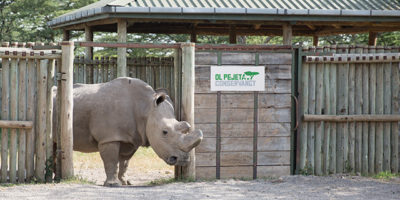The world's last male northern white rhino at the Ol Pejeta Conservancy in Kenya. Ol Pejeta Conservancy
Sudan, the world’s last remaining male northern white rhino, has died at the Ol Pejeta Conservancy in Kenya — pushing the species even closer to extinction after decades of poaching. Just two females of the subspecies remain alive today, Sudan’s daughter and granddaughter.
“Sudan was the last northern white rhino that was born in the wild,” Jan Stejskal of Dvur Kralove Zoo in the Czech Republic, where Sudan lived until 2009, told the AFP news agency. “His death is a cruel symbol of human disregard for nature and it saddened everyone who knew him.”
Sudan was 45 years old when he died, the equivalent of 90 in human years. He had been struggling with declining health for several years and had recently suffered a series of infections.
Northern white rhinos originally inhabited Uganda, the Central African Republic, Sudan, the Democratic Republic of the Congo, and Chad, but their populations were decimated by rampant poaching in the 1970s and 1980s. Poachers killed the animals for their horns, which are used in traditional Chinese medicine and also are prized in Yemen as dagger handles. By 2008, the subspecies was considered extinct in the wild. Two males and two females were transferred from zoos to the Ol Pejeta Conservancy in the hope that being in an environment close to their native habitat would help them breed successfully. But these efforts failed, with neither female producing offspring.
Conservationists are now hoping to develop in vitro fertilization (IVF) techniques to save the northern white rhino, the BBC reported. Sudan’s genetic material was collected the day he died, and scientists previously collected and stored material from several other northern white rhino males before their deaths. The IVF process will involve fertilizing an egg from one of the subspecies’ remaining females and implanting it in a surrogate southern white rhino. The procedure could costs upwards of $10 million and could take another decade to perfect, but scientists see it as the only way for the population to continue.



